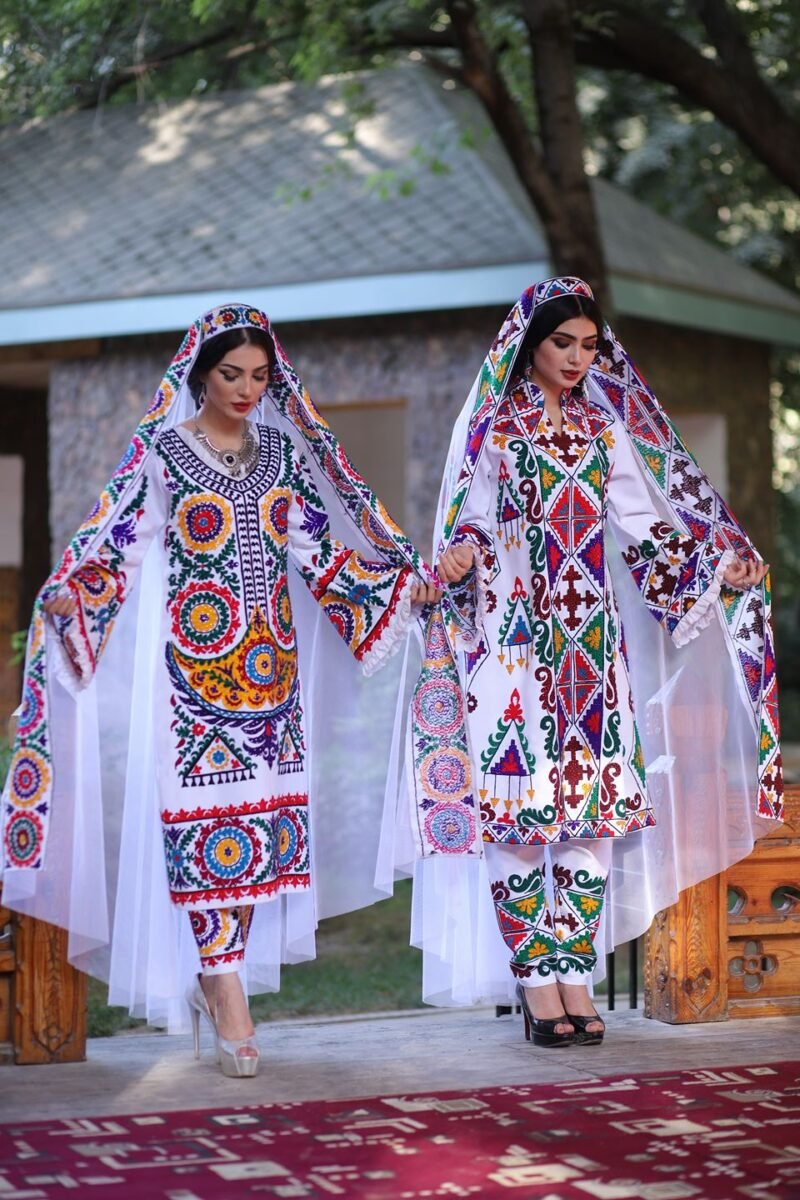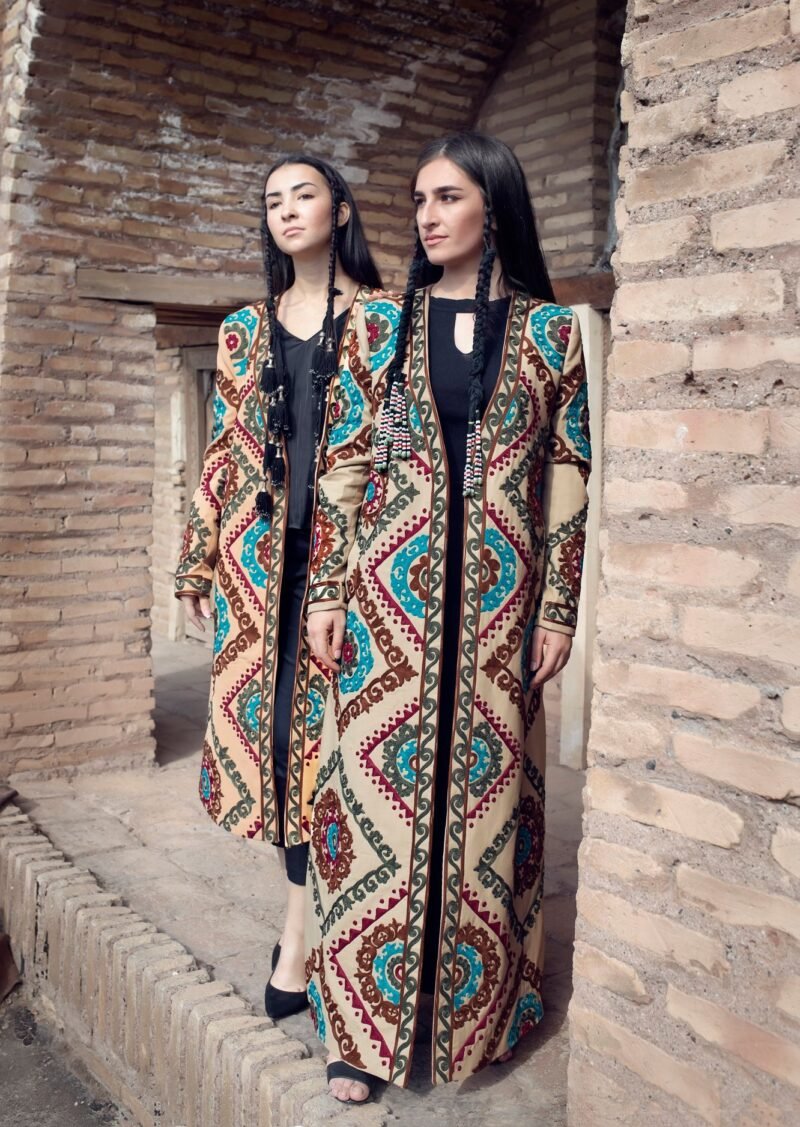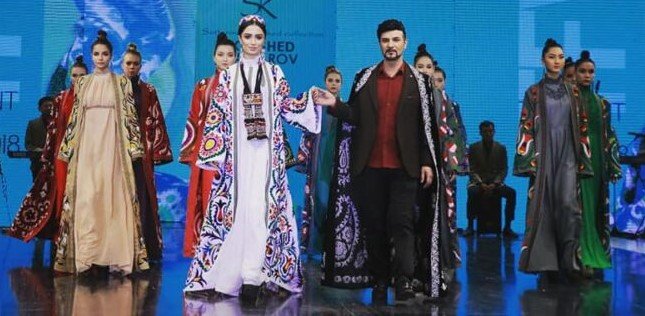 Could this be the long-awaited breakthrough sought by Tajik artists that have been trying to send a message to the world about the clothes and style of the small mountainous republic lost in Central Asia?, writes Lolisanam Ugulva in the Voices on Central Asia, an online research journal.
Could this be the long-awaited breakthrough sought by Tajik artists that have been trying to send a message to the world about the clothes and style of the small mountainous republic lost in Central Asia?, writes Lolisanam Ugulva in the Voices on Central Asia, an online research journal.
Just recently, Tajikistan, with its rich aesthetic traditions, has seemingly made a breakthrough in the fashion arena with some great designers like Khurshed Sattorov (born in 1981), Nafisa Imronova (1991) and Umed Kuchkaliev (1979). At the end of 2019, Sattorov was awarded the honorary title of visiting professor at the Beijing City University, which will allow him to promote the history of his country’s cultural heritage in China during the length of his professorship in 2020. Nafisa Imronova has also received recent recognition, as she has been selected to participate in an upcoming fashion show in France. And, for the first time in the history of the Tajik fashion industry, the brand ZHIWJ by Nafisa Imranova has represented Tajikistan at the Paris Oriental Fashion Show in the Louvre. Nafisa’s brand, ZHIWJ, showed her new Navruz collection, which encompassed the rich history and culture of the Tajik people.

A glance to history
In the recent past, the Tajik fashion industry developed similarly to the fashion industries of the other former Soviet republics. There were educational institutions at the middle (uchilische) and higher (institute) level to train fashion designers for light industry factories. Graduates were supposed to be high profile specialists, having knowledge about the material (fabric and accessories), and about the history and ethnography of the region. Svetlana Gnatush (1956), who lived and worked as the chief fashion designer in Tajikistan’s Republican House of Models and left the country during the civil war (1992-1997), believes that the fashion industry in Soviet Tajikistan developed at a rapid pace. She argues that Tajiks had always adored and possessed the desire to dress stylishly. “Fashion is self-expression, a demonstration of your personality, an opportunity to show that you are not like everyone else, and this is very true with regard to Tajiks,” she says.

She recalls that at one of the last events of the USSR in Almaty (Almaty) in 1990, a Fashion Festival, the Tajik team won almost all the prizes, having distinguished themselves in the “Avant-garde in knitwear,” “Men’s Clothing,” and “Modern Clothing” nominations due to Gnatush’s authorship. The Tajik Republican House of Models even had an agreement with India on the mass production of joint apparel, and they had presented a catalog of products with an affiliate of Unitech International, an Indian joint venture named Khovar TT. Unfortunately, all of these arrangements ended up left on paper because of the break-up of the Soviet Union.

Looking at Svetlana Gnatush’s photos of past years, it is immediately noticeable that there is a big difference between what they sewed/how they dressed before and what Tajik fashion designers offer their clients now. One could admit that there was little Tajik flavor in the previous era of clothes—an observation I made to Svetlana: there was nothing original except for ornaments and patterns in previous models of the Soviet period in Tajik clothing. Her response was that this was the state order (zakaz). “We had to dress people in a modern way,” said the artist.

The main censorship body at the time was the art council, which made plant or factory level decisions for the fashion industry in each republic. Artistic councils in Moscow established a dressing policy across the entire Soviet country. It was a state policy that advised what people in each republic would/should wear. Along the way, I was able to see how the principle of what and how to dress remained the same in Tajikistan, which inherited a Soviet dressing policy that was soon adapted into a national recommendations agenda. The Ministry of Culture introduced a book of recommendations that told women what they should (and should not) wear. The book is filled with photos of models wearing outfits suitable for “women from seven to seventy.”

In the past, the habitual manner of dressing in Soviet life was largely practical: although it incorporated ornaments and patterns in various regions of the country, it was easy for this to become lost among other models of fashion designers from other Soviet republics. What Tajik fashion designers are doing now is very different from what they did before, but very much like what neighboring countries in the region are also doing.
Ethnic ornaments in the synthesis of a traditional costume with European clothes are the distinguishing traits of fashionable clothes of Tajik couturiers. These features have become an integral part of any designer’s costume and repertoire.

Key players in the field
The fashion industry began its development in an independent Tajikistan after the end of the civil war (1991-1997), when the country was getting back on its feet and rebuilding its infrastructure with external support. This was when Khurshed Sattorov, Farvardin Atashin, and Umed Kuchkaliev began their career in fashion as non-professionals—although Kuchkaliev later received a diploma in clothing design from the local Technological University. Incidentally, he held his first show at a nightclub in 2005, which was called “Oriental Dreams,” believing nightclubs to be a suitable place to find wealthy clients.
As one of the vanguards of Tajikistan’s fashion industry, Mavluda Khamraeva (1973) described them as follows, identifying their specific areas of skill and specialism: Khurshed Sattorov was strong in embroidery (gulduzi), Farvardin Otashin in sewing technology, and Umed Kuchkaliev in cut patterns. Mavluda Hamraeva wanted to help with the modernization of the country’s fashion industry after the collapse of the Soviet Union. Having a background in economics but coming from a creative family, she actively helped rebuild the country.
 Umed-Kuchkaliev-Odessa-Fashion-Week-2016-Kuchkaliev-photo-archive
Umed-Kuchkaliev-Odessa-Fashion-Week-2016-Kuchkaliev-photo-archive
According to Khamraeva, she began with the manufacturing of children’s clothing, of which there was an acute shortage in the destroyed country. Her first showroom opened in Khojent (in the center of the Sogd province) in 1998, and she gained momentum by serving the population with good-quality clothes. She led the list of fashion designers at the 2002 Arjang festival—the first cultural event organized by the Swiss Office for Cooperation in Tajikistan—celebrating peace and affluence in the post-civil war era along with Ravshana Sheralieva (1986) and Mukaramma Kayumova (1953).
While Sheralieva was still an inexperienced designer of clothes and tried to present outfits with a European cut, Mukaramma Kayumova, one of the famous masters in the technique of zar-douzi(embroidery in gold) and an already established clothing designer, was focused only on her highly individual production of traditional wear, which mainly dressed participants at weddings and celebrations. Prices for such products could often only be affordable to wealthy clients, or men who had saved for weddings.

Nafisa Imronova joined the fashion industry of the country later. She immediately made a name for herself as an audacious designer of collectible clothes in white and red colors, taking the basis of the traditional costume of the people of Badakhshan, where she herself came from. In her first collection “Kuhihoi Pomir” (the Pamir mountains), white and red colors were dominant (the main colors of the Badakhshan folk costume, where white represents the purity of the human soul, and red is the color of the amulet that does not allow the unkind spirits to harm the owner of the clothes). She, like her fellow designers, began to synthesize a European cut with a traditional Tajik dress, modifying it, turning it into an authorial ensemble. Participation in many international level training in the USA, Singapore, and Italy allowed her to learn the basics of a modern approach to the functioning of her brand.
The fact that it was her brand, ZHIWJ, that was chosen to participate in the Paris Oriental Fashion Show in the Louvre indicates both the modern approach to her organization of her business and her love for passionate connoisseurs of the traditions of her people.

Supplementation
Exploring the topic of fashion and its development in Tajikistan, I met with various key people in this area. Here, there are few specialists in the field of fashion as a sphere of reflection of society, its norms, style, etiquette, and organization of space. Among them is a specialist with a degree in the history of Tajik costume, Gulrukhsor Umarova, (1978) who holds a PhD from the Stroganov Academy in Russia. She also believes that the role of clothing among Tajiks is important in the context of belonging to an ethnic group, region, and aesthetic setting. She says that national traditions were preserved only in Tajik women’s clothing and have a certain semantic load. Each region had its own cut of clothes, patterns, and ornaments, also a way to tie scarves. In general, the Tajik people are distinguished by the brightness of colors in their clothes, only blue was the color of mourning, and black was generally considered not to be a “lucky” color. And today, this color remains “excluded” from the color palette in clothes, alluding to its alienness, the hostility introduced from outside, and its association with radical Islam.
“Each region had its own cut of clothes, patterns, and ornaments, also a way to tie scarves.”

Umarova asserts that the stars of the Tajik scene—as well as the heroines of Turkish TV soap operas and the merchants of imported fabrics—all contribute to the creation of fashionable trends in Tajikistan. She says that in spite of the boom of fashion design and the country’s awareness of style, it is at risk of being unable to develop because everyone has the same cut, the same robe, and the same length of cardigans and jackets. When it comes to global trends of fashion, we are not subject to these trends. In fashion, the silhouette, length, color, cut, decor, and fabric should change and should be varied, but in the Tajik fashion context, these elements are stagnant. Stage costumes dominate the industry because all young designers prefer to sew for singers and young girls, fashion lovers, who can afford to pay. According to Umarova, fashion is a phenomenon invented by men and aimed at the imitation and worship of idols—envy often drives local fashionistas, and the suggestions of family and society (religious and family values) contribute to the development of fashion in Tajikistan.
Speaking of the role and significance of embroideries and patterns, I also met Dilshod Rahimi (1974), deputy director of the Research Institute of Culture and Information of Tajikistan. He spoke in detail about the “chakan” art of embroidery. There is a whole gallery of clothes with embroidered chakans, from a headdress (tokki-chakan), to outerwear garments (dress-chakan), to the bedspread (suzani). The “chakan” art of embroidery is included in the UNESCO Representative List of the Intangible Cultural Heritage of Humanity, about which Dilshod Rahimi proudly told me.
Investigating the subject of fabrics for fashionable clothes, I met with Nasibakhon Aminova (1978), the executive director of the National Association of Small and Medium Enterprises of the Republic of Tajikistan
She told me that designers mainly purchase fabrics offered by merchants brought in from China, and sometimes from Turkey and Kyrgyzstan. She looks at fashion designers as part of the craft production process, but with a large share of creative enthusiasm in their works.
According to Aminova, despite the fact that some fashion designers, such as Khurshed Sattorov, have their own laboratory for the production of own collections and have attracted specialists in this field from the Technological University, this is not enough to enable real discussion about the great achievements in the country’s fashion industry. The fashion industry is still far from getting to mass production. For the fashion industry to really work well, it needs to combine the efforts of artisans with fashion designers: those who can sew or cut must unite with those who can sell and promote products. Positive developments have occurred: the protection of the rights and interests of artisans is improving; NAMSB has recently implemented a project aimed at promoting the development of the private sector in Tajikistan and Kyrgyzstan; and there is an increase of demand and competitiveness in the domestic and international markets. In Tajikistan, there are small factories for the production of national fabrics such as adras (ikat) and atlas(silk), but the quality of these fabrics is inferior to similar products in Margilan (Uzbekistan).
Conclusion
There are three educational art institutions in Tajikistan that train specialists in the field of modeling and fashion design. New applicants to these institutions dream of fame and financial success, looking at the big names of the fashion industry that are already in high demand in the local market. If you want to buy clothes from Imronova, Sattorov, or Kuchkaliev, it will cost you hundreds–usually starting at a price of at least $100 for the more affordable options. Not cheap at all. But even the successful lines from these designers fall short of the scale necessary to become a full-cycle industry within the developed local and neighboring market, with its own production of fabric and accessories, a strong sense of identity, and a modern aesthetic (not to mention the ability to respond to the huge impact of environmentalism and the need for sustainability in today’s fashion industry). The current modeling and fashion design students of Tajikistan’s art institutions will need to understand and navigate all of these challenges in order to fully realize the potential of Tajikistan’s fashion industry going forward.
Lolisanam Ulugova
 Lolisanam has been an art manager in Tajikistan since 2000. She has contributed to writing and producing the nation’s first 3-D animation film, a short designed to promote awareness of environmental issues among children. She holds a Master’s degree from the University of Turin, Italy and an undergraduate degree in Russian Language and Literature. She was a Global Cultural Fellow at the Institute for International Cultural Relations at the University of Edinburgh and participated in the Central Asian-Azerbaijan (CAAFP) fellowship program at the George Washington University at Elliott School of International Affairs for Fall 2019.
Lolisanam has been an art manager in Tajikistan since 2000. She has contributed to writing and producing the nation’s first 3-D animation film, a short designed to promote awareness of environmental issues among children. She holds a Master’s degree from the University of Turin, Italy and an undergraduate degree in Russian Language and Literature. She was a Global Cultural Fellow at the Institute for International Cultural Relations at the University of Edinburgh and participated in the Central Asian-Azerbaijan (CAAFP) fellowship program at the George Washington University at Elliott School of International Affairs for Fall 2019.

The High Asia Herald is a member of High Asia Media Group — a window to High Asia and Central Asia

